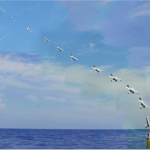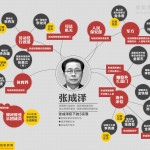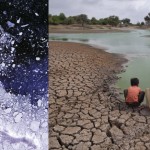- DETERRENCE: Navy launches drone from an underwater submarine
- DPRK: Public ouster in North Korea unsettles China
- ENERGY SECURITY: Nuclear scare stories are a gift to the truly lethal coal industry
- GOVERNANCE AND CIVIL SOCIETY: “How are you?” student movement becomes nationwide phenomenon
- CLIMATE CHANGE ADAPTATION: Climate change and health: A tool to estimate health and adaptation costs
- CLIMATE CHANGE AND SECURITY: Abrupt impacts of climate change: anticipating surprises
 DETERRENCE: Navy launches drone from an underwater submarine, W. Hennigan, Los Angeles Times (6 December 2013)
DETERRENCE: Navy launches drone from an underwater submarine, W. Hennigan, Los Angeles Times (6 December 2013)
The Navy launched an electric fuel-cell powered XFC drone from a torpedo tube of submerged SSN USS Providence. The XFC beams video back to a submarine for six hours, thereby proving the concept of sub-launched drones to support special operations forces. Image source: Naval Sea System Command
- Secret new UAS shows stealth, efficiency advances, Amy Butler, Bill Sweetman, Aviation Week and Space Technology (6 December 2013)
- Air Force suspends teleworking drone operator after wedding party bombed, Paul, The Duffel Blog, December 13, 2013 [warning: this item is satirical]
 DPRK: Public ouster in North Korea unsettles China, Jane Perlez and Choe Sang-hun, The New York Times (9 December 2013)
DPRK: Public ouster in North Korea unsettles China, Jane Perlez and Choe Sang-hun, The New York Times (9 December 2013)
North Korea executed Jang Song-taek and severed many links to China. North Korea’s songbun policy punishes up to three generations removed from the guilty party; Jang’s execution will have a disruptive ripple effect. In two years, Kim Jong-un “adjusted” five of seven advisors close to Kim Jong-il. Kim Jong-un’s rule is likely secure for the next few years. China should invite him to visit as Kim is the only one who will not be purged.
- Kim Jong-un’s reign of fear: What’s next? Scott Snyder, Los Angeles Times (16 December 2013)
- North Korea purge confounds China, Jeremy Page, The Wall Street Journal Marketwatch (17 December 2013)
- NK purge first of a ‘series’, Wang Lili and Sun Xiaobo, China Global Times (10 December 2013)
ENERGY SECURITY: Nuclear scare stories are a gift to the truly lethal coal industry, George Monbiot, Guardian (16 December 2013)
And climate scare stories are a gift to the unspeakably dangerous nuclear industry, leave aside the fact that the chances of nuclear – or any other so-called ‘zero-carbon’ energy option – to substitute for all coal by 2050 are precisely zero. The net global warming impact of new coal power over that period is, too, close to zero, if severe SO2 controls can be avoided. In the meantime, climate and war wreak a havoc in Jordan and Syria, and air pollution does a silent kill in cities from Shanghai to Tehran, and elsewhere. Image source: ChinaFotoPress via Getty Images
- Parched Jordan faces water crisis as Syrian refugees flood in, Sulafah Shami, Thomson Reuters Foundation (17 December 2013)
- Shanghai tells children to stay inside for 7th smoggy day, Bloomberg News (9 December 2013)
- Four Iranian cities rank among world’s 10 most polluted, Radio Zamaneh via Eurasia Review (4 December 2013)
GOVERNANCE AND CIVIL SOCIETY: “How are you?” student movement becomes nationwide phenomenon, Song Ho-kyun, June Dae-ha and Jeon Jin-sik, Hankyoreh (17 December 2013)
Students across university and high school campuses have put up posters expressing students’ frustrations with politics and society in the ROK and calling on youth to become more active in societal issues. The movement has spread into various levels of society, in response to scandals surrounding the National Intelligence Service and the treatment of unionized workers from the nation’s rail agency currently on strike. Image source: Aju News
- Police raid KORAIL union offices, Korea Times (17 December 2013)
- Expressions of disapproval, Joongang Ilbo (18 December 2013)
 CLIMATE CHANGE ADAPTATION: Climate change and health: A tool to estimate health and adaptation costs, WHO Regional Office for Europe, WHO (2013) [8.30 MB, PDF]
CLIMATE CHANGE ADAPTATION: Climate change and health: A tool to estimate health and adaptation costs, WHO Regional Office for Europe, WHO (2013) [8.30 MB, PDF]
The economic analysis tools assist health adaptation planning. These tools provide support on estimating: the costs linked with climate change related health impacts; the costs for adaptation in a range of sectors to guard health from climate change impacts, and (c) the effectiveness of adaptation actions (adaptation costs vs. intended outcomes). Image source: Frank Rumpenhorst DPA /LANDOV
- Climate change, extreme weather events and public health – Meeting report, WHO Regional Office for Europe, WHO (2010)
- Protecting health from climate change: A seven country initiative, WHO Regional Office for Europe, WHO (2013)
 CLIMATE CHANGE AND SECURITY: Abrupt impacts of climate change: anticipating surprises, National Research Council (3 December 2013)
CLIMATE CHANGE AND SECURITY: Abrupt impacts of climate change: anticipating surprises, National Research Council (3 December 2013)
‘An example of an abrupt change is the opening of shipping lanes in the Arctic. The timescale of concern is years to decades. A key characteristic of these changes is that they can come faster than expected, planned, or budgeted for, forcing more reactive, rather than proactive, modes of behaviour. An Abrupt Change Early Warning System (ACEWS) would allow for the prediction and possible mitigation of such changes before their societal impacts are severe.’
- Gazprom’s over-reaction to Arctic oil protest is a sign their fortune is at stake, Kumi Naidoo, The Guardian (13 December 2013)
- Media failure on Iraq War repeated in climate change coverage, Stephan Lewandowsky, Climate Consensus – the 97% [blog], The Guardian (6 December 2013)
- From climate change and security impacts to sustainability transition: two policy debates and scientific discourses, Hans Günter Brauch, in U. Oswald Spring et al. (eds.), Expanding Peace Ecology: Peace, Security, Sustainability, Equity and Gender, SpringerBriefs in Environment, Security, Development and Peace 12 (2014)
The Nautilus Peace and Security Weekly Report presents articles and full length reports each week in six categories: Austral security, nuclear deterrence, energy security, climate change and security, the DPRK, climate change adaptation and governance and civil society. Our team of contributors carefully select items that highlight the links between these themes and the three regions in which our offices are found—North America, Northeast Asia, and the Austral-Asia region.
Subscribe to NAPSNet to receive free weekly email reports
Editor
Contributors
- Deterrence: Peter Hayes
- Governance and Civil Society: Dyana Mardon
- Climate Change Adaptation: Saleem Janjua
- DPRK: Roger Cavazos
- Energy Security: Nikhil Desai
- Climate Change and Security: Richard Tanter

